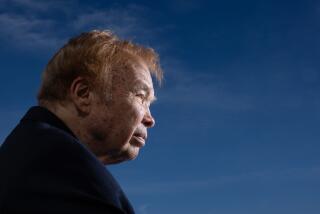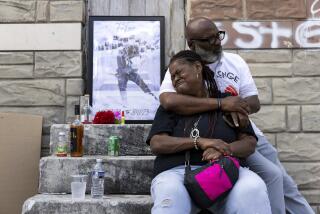Tending These Candles, He Waxes Hopeful
- Share via
In the darkness a man kneels on the sidewalk, tending a small sea of candles.
At 10 p.m. the man is alone with his work. The ministers have left. The crowd has retreated to wherever crowds go when TV and newspaper cameras leave.
And now the candles need attention.
Rodney Edwards lifts one small white candle from a row of votives and touches it to the wick of another whose flame has died.
Careful not to disturb the row, he picks up a large candle encased in glass and pours off the excess melted wax into the street. Then he picks up another and does the same.
This work of lighting and pouring and rearranging holds his full attention. He barely looks up when someone asks him a question. When he answers, he continues to work, as if talking to the candles.
“This is a good boy,” he says, standing back to find another candle in need of help. “Boy was working two jobs. He turned his life completely around.”
The candles sit at the base of a street light at 10th Avenue and 63rd Street in Hyde Park, near the spot where 21-year-old Nahun Beaird was gunned down -- shot once in the head, twice in the chest.
It is the kind of gang violence that makes memorials grow on sidewalks and street corners. A sidewalk memorial is like a tombstone, but is built piece by piece, each candle, each stuffed animal part of the monument to the dead.
The epitaph here has many authors, including family, friends and strangers: “I Love You Baby,” wrote Audrey. “Rest in Peace, S-Dome” and “We Love You,” read other notes left on sheets of paper taped to the light pole.
Someone has tied a bouquet of artificial flowers, roses of red velvet, around the pole. Above are tied two blue bandanas -- the sign of a notorious street gang.
“I don’t know why that’s there,” Edwards says as he steps back and looks up at the bandanas. “He left that behind.”
Edwards is tall, lean and dreadlocked. Years ago a blue rag was his state flag. He was a gangster then, banging hard. That life left him with tattoos, war wounds and stories the 46-year-old still cannot tell.
“Things I did in the neighborhood, I was supposed to be dead or in prison for life,” he says. Taking a scrap of paper from the sidewalk, he lights it and uses it to relight another candle. “I can’t tell you the things I did.”
For his deeds he paid a price. Shot on three different occasions. Once he was shot right in front of the apartment building near where Beaird died.
“I was dead,” he says. “They brought me back.”
A woman walks up and stands mostly quiet, paying her respects to Beaird.
“All ‘cause of some stupid” stuff, she says. “We got to teach our kids better than this.”
For Edwards, getting shot and being near death did not make him stop banging. Neither did becoming the father of a baby girl and then another girl.
But then his son was born, and everything changed. Something about having a boy made him think hard about how he was living his life. Then he found his way to Cedar Grove Baptist Church -- and, he says, forgiveness.
“I turned my life around,” he says.
Not every young man gets a chance to change. In the time it takes a young man to grow up -- to find his way into the gang life, then find his way out -- life itself can end, redemption cut short by a bullet.
Getting out of that life can be harder than getting into it.
To this day, Edwards says, “I watch my surroundings.”
The day of Beaird’s death, he and Edwards had talked. Edwards is an auto mechanic now. Beaird, who had recently celebrated his birthday, wanted his car worked on. He seemed happy.
“This man had two jobs,” Edwards says again, sounding like a proud father. “He was trying to have a child.”
When Beaird wasn’t working at Burger King or driving a cab, he was inside the apartment he shared with his girlfriend, Audrey.
On that final day, Aug. 24, Beaird stepped outside his apartment building and a car drove by. From up the street, Edwards heard shots but did not know someone had been hit.
“I would’ve been trying to revive him, hold the holes, plug ‘em up until the ambulance came,” Edwards says.
He was not present for the angry commotion that followed. After the shooting, paramedics determined Beaird was dead and covered his body. Some in the crowd said they saw Beaird move and they demanded that paramedics continue to try to save him. Police and firefighters would later say that Beaird was dead.
The next day, what was to be a vigil for Beaird became a confrontation between police and a large group of people, including Tony Muhammad, a minister with the Nation of Islam. The day after that altercation, another gathering would occur in the courtyard of the apartment where Beaird lived.
Members of the Nation of Islam would drive down the street addressing the crowd through a loudspeaker. A Christian minister would pray for peace. Police would monitor the gathering from a distance.
In the days that followed, Muhammad would face charges related to the altercation. Beaird’s killer or killers would remain unfound, and the memorial would change.
The blue bandanas would disappear and some of the candles would melt away, leaving a swirling white mass of wax on the grass.
Except for one, all of the candles would burn out.
But all of that would happen over the next few days. On this night, two nights after Beaird was killed, the candles remain lit. Edwards keeps them that way.
The crowd is gone and the street is as quiet as a city street can get. Up close, the flickering of candles almost seems audible, tiny waving flames asking to be heard above the distant siren, the helicopter, the muffled sounds of life seeping from the apartment building.
No one elected Edwards to care for the candles. It needs to be done, so he does it. Now, the glow of the candles beneath the street light makes this the brightest spot on the street.
For one brief moment, this piece of sidewalk feels like a holy place.
More to Read
Sign up for Essential California
The most important California stories and recommendations in your inbox every morning.
You may occasionally receive promotional content from the Los Angeles Times.









